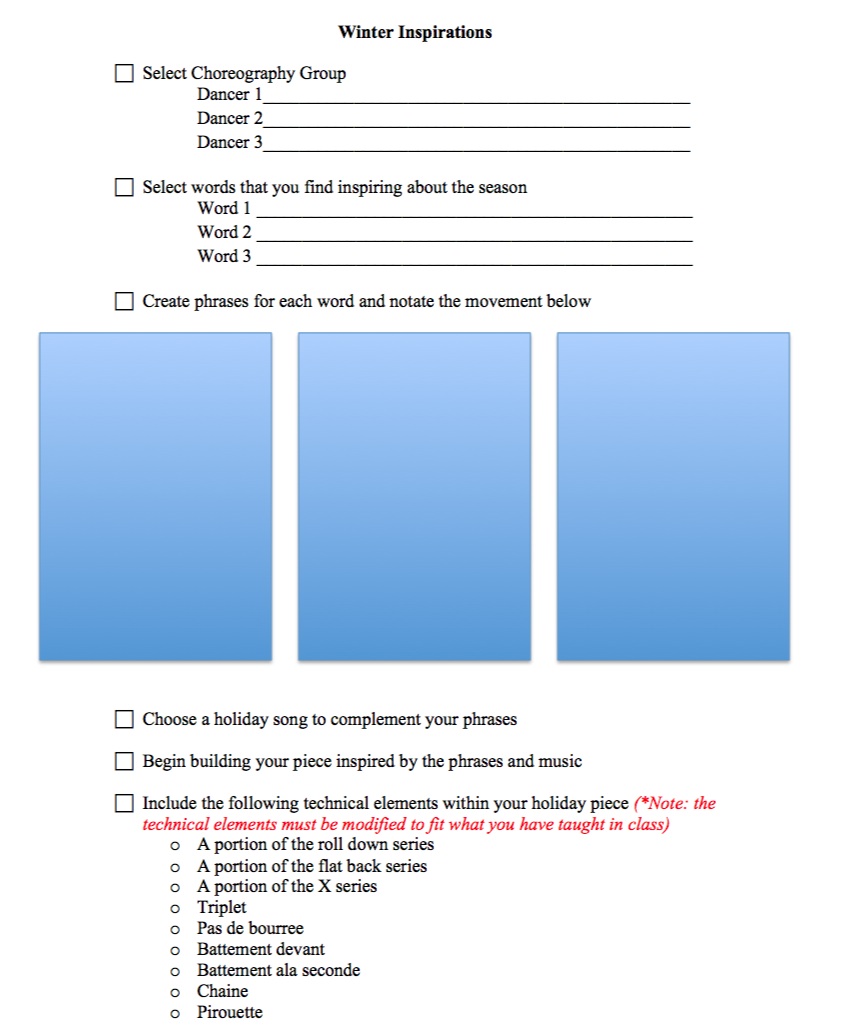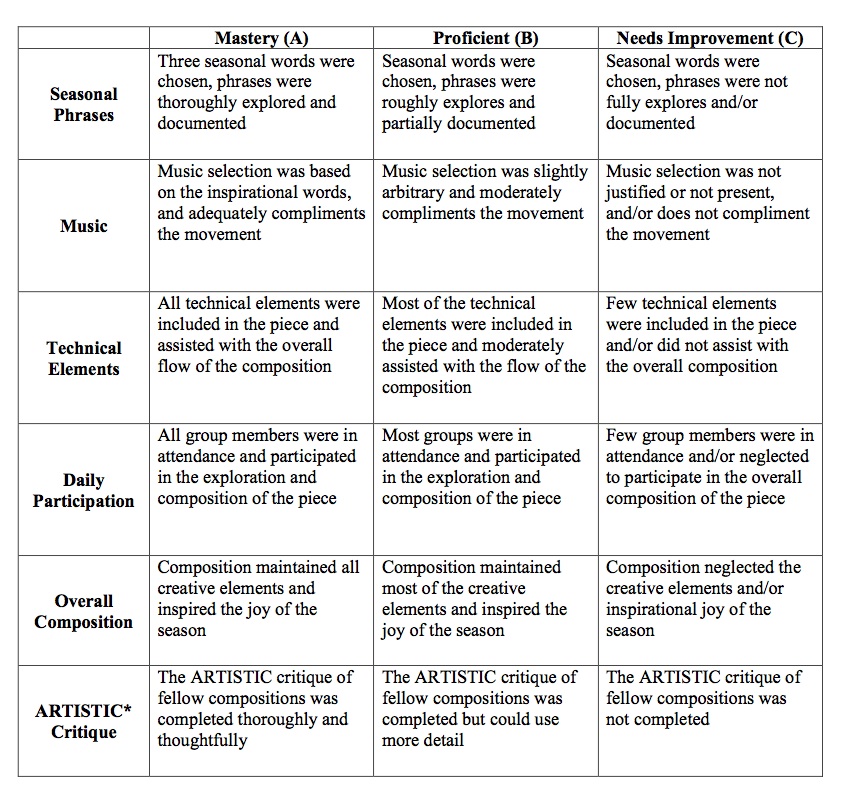Standard 5: Lessons & Assessments
6 Min Read • Dance
This month we will explore Standard 5: Developing and refining artistic technique and work for presentation
Anchor standard 5 focuses on the artistic process of performing with the component of embody. The enduring understanding is how dancers use the mind-body connection and develop the body as an instrument for artistry and artistic expression. Although the anchor standard 5 does not change as the grade level progresses the expectation continues to advance.
In unpacking this standard 5 we need to analyze what our students need to know, understand, and be able to do. There are quite a few concepts presented in this standard 5, so let’s begin with defining the language:
Artistic Expression: The manifestations of artistic intent though dance, drama music, poetry, fiction, painting, sculpture or other artistic media. In dance, this involves the dance and the dancers within a context
Anatomical Principles: The way the human body’s skeletal, muscular and vascular systems work separately and in coordination
Body-Mind Principles: Concepts explored and/or employed to support body-mind connections (for example, breath, awareness of the environment, grounding, movement initiation, use of imagery,intention, inner-outer, stability-mobility
Body Patterning: Neuromuscular patterns (for example, core-distal, head-tail, homologous
Dance Phrases: brief sequence of related movements that have a sense of continuity and artistic or rhythmic completion
Functional Alignment: The organization of the skeleton and musculature in a relationship to gravity that supports safe and efficient movement while dancing
General Space: Spatial orientation that is not focused towards one area of a studio or stage
Genres: A category of dance characterized by similarities in form, style, purpose, or subjectmatter (for example, ballet, hip hop, modern, ballroom, cultural practices)
Kinesthetic Awareness: Pertaining to sensations and understanding of bodily movement
Locomotor: Movement that travels from one location to another or in a pathway through space (for example, in PreK, walk, run, tip-toe, slither, roll, crawl, jump, march, gallop; in Kindergarten, the addition of prance, hop, skip, slide, leap)
Movement Characteristics: The qualities, elements, or dynamics that describe or define a movement
Movement problems: A specific focus that requires one find a solution and complete a task; gives direction and exploration in composition
Non-locomotor: Movement that remains in place; movement that does not travel from one location to another or in a pathway through space for example, in PreK, bend, twist, turn, open, close; in Kindergarten, swing, sway, spin, reach, pull)
Personal Space: The area of space directly surrounding one’s body extending as far as a person can reach; also called the kinesphere
Styles: Dance that has specific movement characteristics, qualities, or principles that give it distinctive identity (for example, Graham technique is a style of Modern Dance; rhythm tap is a style of Percussive Dance; Macedonian folk dance is a style of International Folk dance; Congolese dance is a style of African Dance)
Technical Dance skills: Is the degree of physical proficiency a dancer achieves within a dance style or technique (for example, coordination, form, strength, speed and range)
*For the full glossary of all terms used throughout the national standards go to: http://www.nationalartsstandards.org/
This standard 5 embodies much of the foundational elements of dance such as technical skills, kinesthetic awareness, body-mind principles, and alignment, which made me curious as to why these elements are not thoroughly explored in the earlier standards. The best I can come up with is that the standards framework is organized by the following processes: Creating, Performing, Responding, and Connecting so the individual standards follow that same organizational structure. We inherently want to find hierarchical justification, but the more I work with the standards the more I am seeing that they are so interchangeable and so greatly build upon each other in many different directions and ways.
There are so many ways to deliver instruction with this standard 5 as it is very robust. Taking a look just at the high school proficient section, we have the following expectations:
a. Embody technical dance skills (for example, functional alignment, coordination, balance, core support, clarity of movement, weight shifts, flexibility/range of motion) to retain and execute dance choreography.
b. Develop a plan for healthful practices in dance activities and everyday life including nutrition and injury prevention. Discuss implementation of the plan and how it supports personal performance goals.
c. Collaborate with peers to establish and implement a rehearsal plan to meet performance goals. Use a variety of strategies to analyze and evaluate performances of self and others (for example, use video recordings of practice to analyze the difference between the way movements look and how they feel to match performance with visual affect). Articulate performance goals and justify reasons for selecting particular practice strategies.
The first section really is the foundational element of most studio class environments and embodies our daily warm-up, center floor adagio, across the floor exercises etc. The second section is also something that we tend to discuss throughout practicum classes, healthy eating, injury prevention etc. however this also includes planning and supporting personal performance goals which could be a nice theoretical lesson within the class where students plan and implement their healthful practices and justification of how the plan supports their personal performance goals. For today’s lesson I am going to focus on the third performance expectation. As we enter the last week before winter break, our students are antsy, squirrly, anxious, and ready for a break, so this lesson is fun and inspired by the excitement of the holiday!
Lesson Plan
Grade: 9-12 (but can be simplified for younger students)
Title: Winter Inspirations
Established Goals: Collaborate with peers to establish and implement a rehearsal plan to meet performance goals. Use a variety of strategies to analyze and evaluate performances of self and others (for example, use video recordings of practice to analyze the difference between the way movements look and how they feel to match performance with visual affect). Articulate performance goals and justify reasons for selecting particular practice strategies.
Enduring Understanding: Dancers use the mind-body connection and develop the body as an instrument for artistry and artistic expression.
Essential Question: What must a dancer do to prepare the mind and body for artistic expression?
Objectives: Students will
- Build Choreographic groups
- Explore movement inspired by the season
- Develop phrases
- Incorporate technical skills into their choreographic challenge
- Utilize video and peer feedback to revise artistic work
- Perform collaborative piece
- Evaluate peers based on selected criteria
Learning Activities
1. Organize class into choreographic groups.
2. Review the assignment expectations handout below.
3. Have students work on their choreographic projects each day.
4. At the culmination of each day have students video tape their progress.
5. Review the videos before each rehearsal to analyze goals and expectations for the day.
6. Perform and critique Winter Inspirations Choreography.
7. Critique peer compositions using the ARTISTIC critique format.
Assignment Expectations
*this is just a sample of what you can do, the expectations need to be modified based on the skills and terminology used within your classroom.

* The ARTISTIC critique is a practical tool for critiquing art. Please see my article ARTISTIC critique for reference
This assignment is a great “right before break” assignment as it keeps students active, holds them accountable, and reinforces learned information as opposed to introducing too many new things right before a break.
Next Week: Teacher Talk
Putting Lipstick on a Pig
What happens when the school leadership is more concerned with the look of the school rather than the efficacy of the school. How can we as arts educators instill the characteristics of persistence, self-control, conscientiousness, grit, and self-confidence as a means to improve culture, morale, responsibility, and decorum in our institutions.




